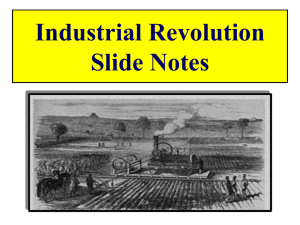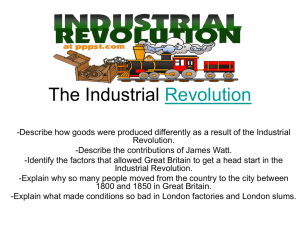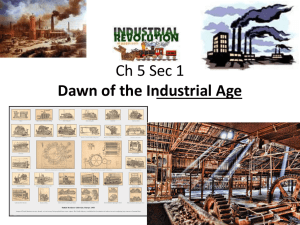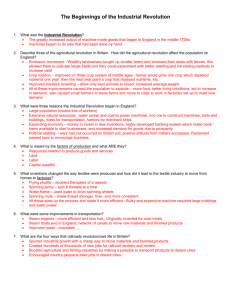Life Before The Industrial Revolution
advertisement
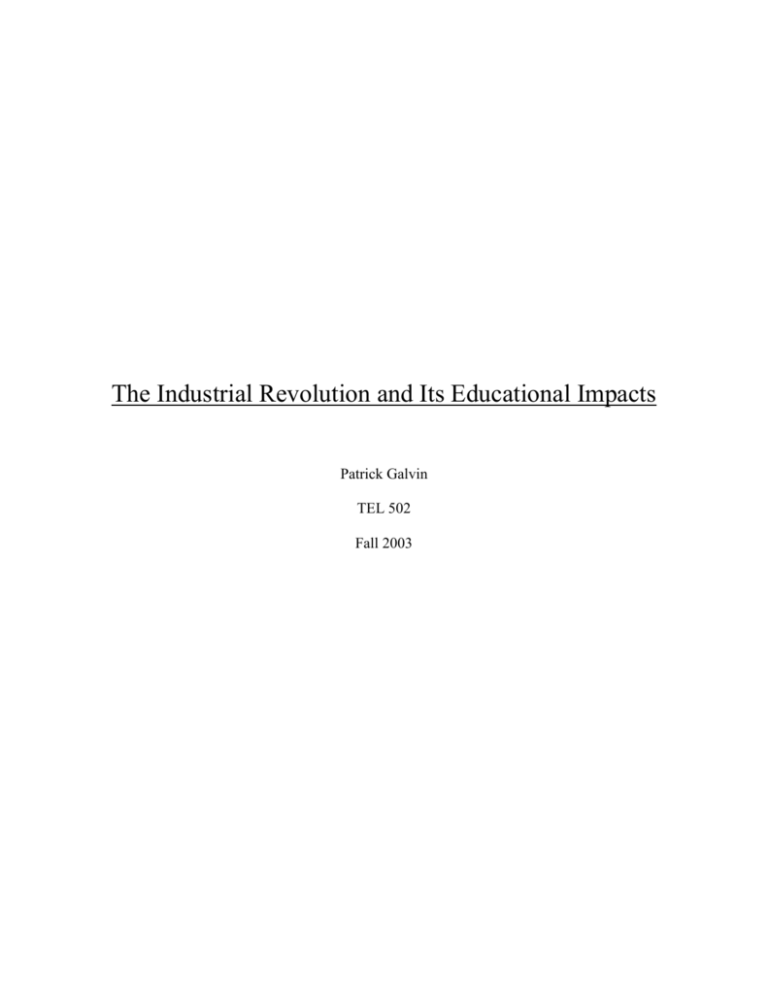
The Industrial Revolution and Its Educational Impacts Patrick Galvin TEL 502 Fall 2003 2 Introduction The Industrial revolution can be described over-simply as the period in history when people applied power to manufacturing machinery. As with many historically significant technological advances, an invention of necessity has lead the way to pervasive application. To more fully describe the era one might include the significance of economic democratization that took place. Mass production of goods allowed average people previously unheard of leisure. Industrialization allowed for mass expansion of a productive middle class. One could parallel the switch from agrarian to industrial economies with the switch from monarchies to democratic government. It is difficult to place an exact date on the beginning of this era, but one can look to the earliest application of machine power to work formerly done by human power. Life before the Industrial Revolution On the eve of the Industrial Revolution, less than 10 percent of European people lived in cities (Rempel, 2001). Small towns and villages were the homes of people that spent their days farming. The industrious few produced enough crops to sell or trade surplus, but most grew just enough for their families. These people made their own clothing, furniture, and tools from raw materials produced on farms or in forests. Of the manufacturing occurring at this time, a portion was taking place in guild shops. Guilds were groups of craftsmen that produced specific goods. The master of a guild passed on his knowledge of a skill, such as blacksmithing, over a period of years to a trainee called a journeyman. Leatherworking, jewelry making, pottery, and cloth making were among the categories of guilds. Most manufacturing of the pre-industrial era occurred in rural homes. Under this “domestic” or “cottage” system families were hired by merchants to produce goods. Entrepreneurs, as they were called, supplied raw materials to workers in their homes and collected the finished products for later sale. The majority of this work was accomplished by hand using crude tools, however waterwheels furnished some power when available. Most people’s lives revolved around the agricultural seasons – planting, cultivating, harvesting, and processing the harvest. Living under the constant threat of failed crops, life was hard and worrisome for most. The distribution of wealth was extremely unequal as only the very elite had the luxury of extra income. The governments of most European countries were monarchies so only a select few had any political leverage. Overall the masses worked very hard for very little. 3 The First Signs of Change The early 1700’s ushered in a period of mechanical refinement where the production of devices such as clocks could be made available to the typical people. Keeping time is such an omnipresent part of our society it is hard to believe that people a few hundred years our prior used the position of the sun in the sky to plan a days events without actually knowing what “time” it was. The majority of people thought that a pocket watch must indeed be possessed by demons in order to show the correct time and fit into one’s pocket. However stunning such an accomplishment, the great innovation was in the combination of machines with external power. In 1712, a mining engineer named Thomas Newcomen built a steam engine to assist in the process of pumping water from the bottom of ore mines. Men who had previously operated the pumps manually now could be employed as diggers. “By 1785 James Watt had further developed the steam engine, eliminating most of its shortcomings, making the engine fuel efficient enough to be viable as a power source for manufacturing” (Rempel, 2001). Precision machining and the steam engine The enormous potential of the steam engine and power driven machinery could not have been achieved without the development of machine tools to accurately shape metal. When Watt began to experiment with the steam engine, he could not find a tool that drilled a perfectly round hole. As a result, his engines leaked steam. In 1775, John Wilkinson invented a boring machine that drilled a more precise hole. Between 1800 and 1825, English inventors developed a planer, which smoothed the surfaces of the steam engine’s metal parts and ensured a highly reliable seal. The steam engine was refined to a very efficient power source. The impact of coal The industrial revolution could not have developed without coal. Coal was not only used as fuel to drive steam engines but was an essential part of the iron making process. Early iron making required the raw ore to be refined to molten iron by heating it in a charcoal fired oven. Since charcoal is derived from wood and England had essentially used up all of her Oak forests another fuel was needed (Harmon, 1999). Abraham Darby developed a method of processing iron ore by using coke, which is derived from coal. England had large coal reserves available so it was a natural fit. At first, the coke-fired iron was brittle and more difficult to shape than charcoal fired iron, but Darby’s son, Abraham II further developed his father’s process to produce easy to manage coke-fired iron. Around the same time, Henry Cort had developed a puddling furnace to purify iron and created advanced rolling machinery 4 to produce iron in shapes other than thin sheets. Prior to Cort’s advances, the relatively impure iron did not easily take to shapes other than sheets. By 1830, nearly all the basic machine tools necessary for modern industry were in general use. The textile industry The production of textiles underwent many changes during the industrial revolution. Machines were used to produce cloth in quantities and qualities unheard of to that point. The cottage industry of textile production included distribution of raw materials like wool and cotton to individual households to be spun into yarn. The yarn was then distributed to households with looms to be woven into cloth. Controlling the consistency of the fabric was difficult and delivery schedules were impossible to meet. The cumbersome nature of distributing and collecting and redistributing and bringing to market added to the inefficiency of the whole process. In 1733, John Kay patented a loom with a “flying shuttle” which greatly increased the speed at which weavers could do their work. In 1779 when Samuel Crompton invented his yarn production machine, called “Crompton’s Mule” the production of strong, high quality yarn finally caught up to the weaver’s ability to produce cloth. In the late 1700’s machines were produced to print patterns on fabrics and in the late 1800’s Northrup’s power loom paved the way for women to become loom operators. Families that had spent their days laboring on farms or producing goods by hand were now available to operate machinery. Children were often used to get into the small spaces inside of the looms to repair parts or retrieve dropped items. Transportation The increased demand for products ignited the need for a faster and more efficient means of transport. The steam engine was put to use for the purpose of transporting goods and people. The first advance, occurring in the late 1700’s was the steamship. Met at first with public scrutiny, the steamship soon gathered favor for its reliability, speed and independence of a need for wind. Railroads became common in England in the early 1800’s. Powered by steam boilers, a locomotive could pull massive amounts of raw materials, finished goods, coal, and later people. By the mid 1850’s railroad tracks traversed England, connecting all of the major commerce centers and allowing people from rural areas access to these burgeoning market places. The success of English railroads led to development of railway systems throughout Europe and further advanced England’s economic dominance. The lessons learned in Europe were taken to the new world and a network of rails soon appeared in America and Canada, where vast distances between communities 5 could now be quickly spanned. Trains were traveling nearly 50 miles an hour. A rumor of the day was that if a train traveled faster than 60 miles per hour (a mile a minute) the laws of physics would cause the train to explode. As it turned out, the train did not explode. Automobiles began to take favor in the early 1900’s because they offered their owners the freedom to choose when and where to go. The development of the internal combustion engine facilitated the automobile’s creation. At first autos were individually hand-built and therefore expensive, often viewed as a plaything of the rich. Roadways of the time also presented a problem, as they lacked the ability to sustain any volume of auto travel. Many people of the day were not ready for such a drastic change in transport. The laws of road travel were written with horse and buggy in mind. We often take for granted “the rules of the road”, but in those days there was nothing regulating the behavior of automobile drivers. Although he did not invent the automobile, Henry Ford did much to make the car an omnipresent part of life in America. His assembly line production of automobiles reduced the cost to a level where average people could afford them. One might compare Ford’s production of automobiles to the entire Industrial Revolution; mass produce goods using power tools and all people can benefit. The widespread societal impacts of Ford’s automotive contributions are immeasurable. Electricity In 1831, Michael Faraday demonstrated how electricity could be produced mechanically. Soon there after, people applied his “dynamo” to machinery and transportation. At first the power of falling water was harnessed using water wheels hooked to generators, later coal burning steam engines drove turbines. As early as 1875, electric textile looms were being operated in Italy (Harmon, 1999). By the early 1900’s, England had constructed an “electric grid” completely covering the country. Starting late with industrialization, Russia used electricity to catch up with the rest of Europe and rapidly develop their industrial base. Undesired outcomes Such massive changes and advances resulted in many positive changes, but the industrial revolution was not without its problems. Massive urbanization caused over crowding which caused a lacked of sanitation which caused health issues. Uncaring factory owners demanded high production, which led to crowded factories, which caused unsafe conditions for workers. Abuses of workers by factory owners included poor wages, long hours and 6 treatment as expendable commodities, not people. Children that had previously worked at home with their families were now working in factories under abusive conditions or roaming the cities causing a rise in crime. Changing social patterns The industrial revolution caused widespread change in all aspects of society. An increase in food production and medical advances caused an increase in population. Availability of economic opportunities perpetuated a burgeoning middle class. The need for a concentrated work force to operate the machines in factories caused mass urbanization. The general pace of society shifted from approximating time to the strict schedules found in factories. Political thought was revamped to include the ideas of Karl Marx and Charles Darwin. Darwin’s central idea was that the free market functioned as a test in the survival of the fittest. The change in social privilege from aristocracy to ambition is the philosophical cornerstone of the era. Education follows this lead and schools become the means by which people are equipped with the appropriate “survival tools”. Educational impacts of industrialization The industrial revolution initiated the rise of capitalism in Europe and in North America. Motivated individuals could easily take advantage of the many economic opportunities of the situation, but the average person would need to be educated in order to do so. In the mid to late 1800’s schools became the mechanism for survival and, for the first time, a means of upward mobility in society. Immigration played a role in American educational change. The dominant theory describing the assimilation of new immigrants had been known as the “melting pot”, and it was assumed that the role of education was to Americanize these people (Harmon, 1999). In 1850, the major influx of immigrants was made up of English speaking people from England, Ireland and Scotland, but by the late 1800’s the majority were non-English speakers. Americanization would now include instruction in a new language. The existing system of education in America was centered in religion. Puritan settlers in New England established schools where students were immersed in secular teachings of the way to live one’s life. Each student received a healthy dose of Bible memorization. Students in American schools spent no more than 5 months out of the year in school, sometimes even less. Most children had responsibilities on family farms or other jobs that preempted their school attendance. In Europe, schools were based primarily on reading and memorization of classical literary works. Schools were a place for the children of wealthy families, so the subject matter was intended to prepare them for a life of privilege. It was becoming glaringly obvious that neither tradition was well suited in 7 preparing people for life in an industrialized society. In 1877, J.R. Buchanan stated, “Education should be a preparation for life and should be like the life to which it prepares” (Barlow, 1967). “The awakening of educational consciousness in the United states occurred about 1820” (Barlow, 1967). Concerned individuals began to advocate change. Reverend Charles Brooks conducted a series of lectures on the Prussian system of normal schools in 1835. The Prussian system, as developed by J.H. Pestalozzi, diverted the emphasis from memorization to “hands-on” activities. Pestalozzi stressed the importance of meaningful experience to create productive people (Smith, 2002). Horace Mann Horace Mann also advocated Pestalozzi’s “Prussian System”. Mann was a senator in Massachusetts who gave up his promising political career to champion the cause of education. He accepted the position of secretary of the Massachusetts state board of education and immediately set out to make changes. Mann can be credited with campaigning for the political changes necessary for widespread educational reform, much needed at the time. He established the first normal school for teacher training in 1839 (Moore, 2001). Mann advocated the establishment of free libraries for all school districts. One of his farthest-reaching accomplishments was instigating recognition of the need for more financial support of schools. “Through his efforts, state aid to education doubled, teachers salaries more than doubled, supervision of teaching improved with compensated school committees and textbooks and educational equipment improved” (Moore, 2001). Mann edited the “Common School Journal” and wrote a series of 12 annual reports that can be closely paralleled with the formation of modern schools in America. “In his 5 th annual report, Mann argued successfully that economic wealth would increase through an educated public. It was therefore in the self-interest of business to pay taxes toward education” (Moore, 2001). “In his 10 th annual report, Mann asserted that education was a natural right for every child. It is a necessary responsibility of the state to insure that education was provided for every child. This report led to the first state law requiring compulsory attendance in school in 1852” (Moore, 2001). “In his 12 th annual report, Mann presented a rationale for the support of public education through taxation. Society improves as a result of an educated public” (Moore, 2001). He argued for nonsectarian schools, so the taxpayer would not be in the position of supporting any established religion with which there might be disagreement in conscience. 8 Educational Legislation The late 1800’s brought about widespread advocacy of educational reform. In the face of much opposition, laws were passed that ensured the formation of schools, which have remained essentially the same to this day. In 1862, the Morrill Act provided lands to establish colleges to teach agricultural and mechanical arts; 11 million acres were set aside. Though much of it was sold off to provide school funds, many land grant colleges were established and exist to this day. In 1867, the United States Department of Education was established under the administration of president Andrew Johnson (Harmon, 1999). In an effort to satisfy the great pressure on people in government to implement new education doctrine, this department was formed to gather statistics regarding the state of education at the time and to find new alternatives. In 1874, the Kalamazoo Decision by the Supreme Court made it legal for states to levy taxes to pay for public schooling (Harmon, 1999). By the turn of the century education was becoming fully integrated into the American cultural mindset and was also becoming fully bureaucratized. Calvin Woodward Woodward recognized the importance of practical experience in strengthening the theoretic knowledge gained through instruction. His vision of a “Manual Training” school came to fruition with the St. Louis Manual Training School of Washington University. “On September 6, 1880, the first class of fifty boys, selected by examinations, began their studies in the first manual training school in the United States” (Barlow, 1967). Woodward’s philosophy was eloquently summarized in the inscription which hung above the entrance to his new school : Hail to the skillful cunning hand! Hail to the cultured mind! Contending for the world’s command, Here let them be combined. (Barlow, 1967) John Dewey As the 20th century began, the stage was set for educational policy to become what it basically is still today. John Dewey expounded the virtues of education and declared that an appropriate school system could improve society, a foundation of his “progressive education movement”. Dewey asserted that the role of education was to encourage individuals to develop their full potential as human beings. He was disconsolate with traditional education, especially rote learning of facts without supporting activities to engage the learners. Dewey declared that children should learn by experience, and as a result they would develop skills, habits and attitudes necessary for them to solve a wide variety of problems while gaining “book knowledge”. 9 “ John Dewey's significance for informal educators lies in a number of areas. First, his belief that education must engage with and enlarge experience has continued to be a significant strand in informal education practice. Second, and linked to this, Dewey's exploration of thinking and reflection - and the associated role of educators - has continued to be an inspiration” (Smith, 2001). “Third, his concern with interaction and environments for learning provide a continuing framework for practice. Last, his passion for democracy, for educating so that all may share in a common life, provides a strong rationale for practice in the associational settings in which informal educators work” (Smith, 2001). Conclusion The impact that the Industrial revolution had on education in the United States is truly what defines education as we know it. The growth of factories and the homogenization of people to the schedule of industry spawned the “factory model” for schools to follow. Teachers’ roles were taken seriously enough to create training schools specifically for their skills. Education in general moved away from a right of privilege to a societal necessity. a growing democracy was mimicked closely by a changing educational system. 10 Bibliography Barlow, M.L. (1967). History of industrial education in the United States. Peoria, Illinois: Chas. A. Bennett Co., Inc. Bennett, C.A. (1937). History of manual and industrial education 1870-1917. Peoria, Illinois: Chas. A. Bennett Co., Inc. Harmon, D. (1999). The industrial revolution in America. Retrieved September 30, 2003, from http://admin.vmi.edu/ir/industrial_revoultion.htm Lampard, E.E. (2001). Industrial Revolution. In World Book 2001 (Vol. 10, pp 246-255). Chicago: World Book Inc. Moore, G. (2001). Horace Mann. Retrieved October 3, 2003, from http://www.cals.ncsu.edu/agexed/aee501/mann.html Rempel, G. (2001). The industrial revolution. Retrieved September 30, 2003, from http://mars.acnet.wnec.edu/~grempel/courses/wc2/lectures/industrialrev.html Smith, M.K. (2002). Johann Pestalozzi and informal education. Retrieved October 1, 2003, from http://www.infed.org/thinkers/et-pest.htm Smith, M.K. (2001). John Dewey. Retrieved October 1, 2001, from http://www.infed.org/thinkers/et-dewey.htm


